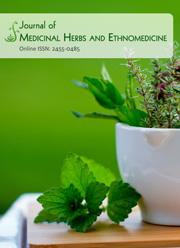Infl uence of indole-3-butyric acid and triazole compounds on the growth and antioxidant constituents in Ashwagandha (Withania somnifera L.) Dunal
Abstract
Withania somnifera (L.) Dunal belongs to the family Solanaceae and commonly known as Ashwagandha, Indian
ginseng and winter cherry is major ayurvedic medicinal plant cultivated specifically for its root portion, which
has medicinal and nutritional values due the presence of clinically important active compounds such as steroidal
lactones, alkaloids, flavonoids, and tannins etc. Ashwagandha root is the medicinal part of the plant and is used
in the ayurvedic formulations and pharmaceutical industries. The present study was undertaken to investigate the
influence of indole-3-butyric acid (IBA) and triazole compounds viz., triadimefon (TDM) and propiconazole (PCZ)
on the growth and non-enzymatic antioxidant content of Ashwagandha. Plants were treated with IBA 2.5 mg/L,
TDM 20 mg/L and PCZ 20 mg/L separately by soil drenching on 50, 90, 130 days after sowing (DAS). Plants
were analyzed on 60, 100 and 140 DAS and it’s parameters such as shoot length, internodal length, number of
leaves, total leaf area, fresh and dry weight of shoot, root length, root diameter, number of roots, fresh and dry
weight of root, ascorbic acid (AA), α-tocopherol (α-toc) and total phenol (TP) contents were determined. It was
observed that shoot length, internodal length, the number of leaves, total leaf area, fresh and dry weight of shoot
decreased, but the root length, root diameter, number of roots fresh and dry weight of roots were increased
higher level. Likewise, the non-enzymatic antioxidants constituents such as AA, α-toc and TP contents were
also increased by TDM and PCZ treatments. But IBA treatment increased all the parameters studied. Among the
treatments, triazole showed beneficial growth by increasing the biomass of root system antioxidant constituents
when compared to IBA treatment. This finding suggested that the triazole compounds showed a great significant
for the cultivation of medicinally important root crops, which is helpful to meet the needs of root production by
enhancing antioxidant constituents in Ashwagandha.



 .
. 